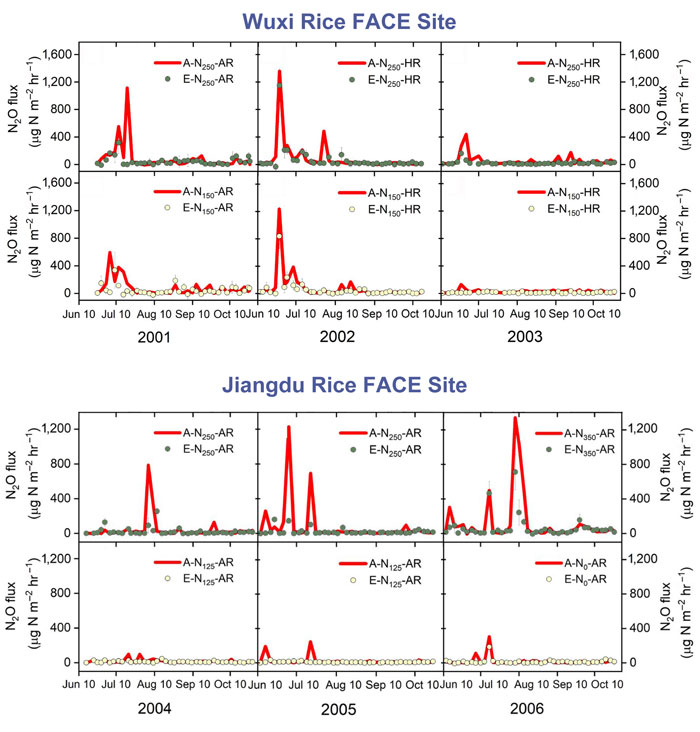CO2-induced Reductions in N2O emissions in a Subtropical Rice Field
Yao, Z., Wang, R., Zheng, X., Mei, B., Zhoe, Z., Xie, B., Dong, H., Liu, C., Han, S., Xu, Z., Butterbach-Bahl, K. and Zhu, J. 2020. Elevated atmospheric CO2 reduces yield-scaled N2O fluxes from subtropical rice systems: Six site-years field experiments. Global Change Biology 27: 327-339.
Nitrous oxide (N2O) is an influential greenhouse gas with a per-molecule global warming potential approximately 300 times that of CO2. Because approximately 60% of the total global anthropogenic N2O emission derive from agricultural activities, increasing efforts are being made to mitigate N2O emissions from this sector of the economy, particularly so as it relates to the application of nitrogen fertilizers.
In this regard, rice paddies have been shown to contribute significantly to global N2O fluxes. In China, for example, total direct N2O emissions are estimated between 32 and 51 Gg N/year, representing 8-11% of the total annual N2O emission from croplands in the country. However, little is known about how such emissions may be altered in the future (if at all) by rising atmospheric CO2. To date, according to Yao et al. (2020) there have been no published field studies using free-air CO2 enrichment (FACE) technology, preventing a proper assessment of the changes in soil N2O fluxes from rice systems under more realistic environmental conditions compared to studies using controlled environment chambers.
To remedy the situation, the team of twelve researchers aggregated and reported on measurements of soil N2O fluxes from two rice FACE studies conducted in subtropical China over the years 2001-2006. The first site, Wuxi (37.62°N, 120.47°E), operated during the years 2001-2003, while the second site, Jiangdu (32.58°N, 119.70°E), was operational from 2004-2006. At both locations the elevated CO2 values were maintained at +200 ppm above ambient and synthetic N fertilizers were applied at a rate of 125-150 or 250-350 kg N/ha, which rates respectively mirrored the upper and lower boundaries of recommended N application for rice cropping systems in the region. In-situ measurements of N2O fluxes were performed throughout the growing season at both locations and are portrayed in the figure below.
In describing their findings Yao et al. write the data “clearly show that soil N2O emissions from the fertilized rice systems were lower under elevated CO2 as compared to those observed under ambient CO2.” This decrease was due to “a sharp reduction in N2O fluxes under elevated CO2 following fertilization and alternate wetting and drying events, but not during the rest of the season.” Nevertheless, total emissions during the peak flux episodes contributed some 50-80% of the seasonal cumulative emissions. Consequently, the season-long area-scaled N2O emissions were 23-61% lower under elevated CO2 at the Wuxi rice FACE site and 28-73% lower at Jiangdu.
Commenting on these findings, the authors state that “under common agricultural practice increasing atmospheric CO2 will result in decreasing soil N2O emissions and increasing rice yields in terms of straw and grain.” What is more, they add the N2O reductions can be further decreased “by improving water regimes and using alternative fertilization practices such as alternate wetting and drying irrigation schemes, ground cover rice production system and urea deep placement,” and by “adopting rice cultivars with potentially strong responses to elevated CO2.”

Figure 1. Seasonal variations in nitrous oxide (N2O) fluxes for different nitrogen (N) fertilization treatments (125, 250 or 350 kg N/ha) under elevated CO2 (E) and ambient CO2 (A) conditions during the 2001-2003 rice seasons at the Wuxi FACE site (upper panel) and the 2004-2006 rice seasons at the Jiangdu FACE site (lower panel). AR = wheat straw soil amendment applied at a rate of approximately 2,000 kg C/ha, HR = wheat straw soil amendment applied at a rate of approximately 1,000 kg C/ha. Adapted from Yao et al. (2020).
This article appeared on the CO2 Science website at http://www.co2science.org/articles/V24/feb/a7.php
]]>